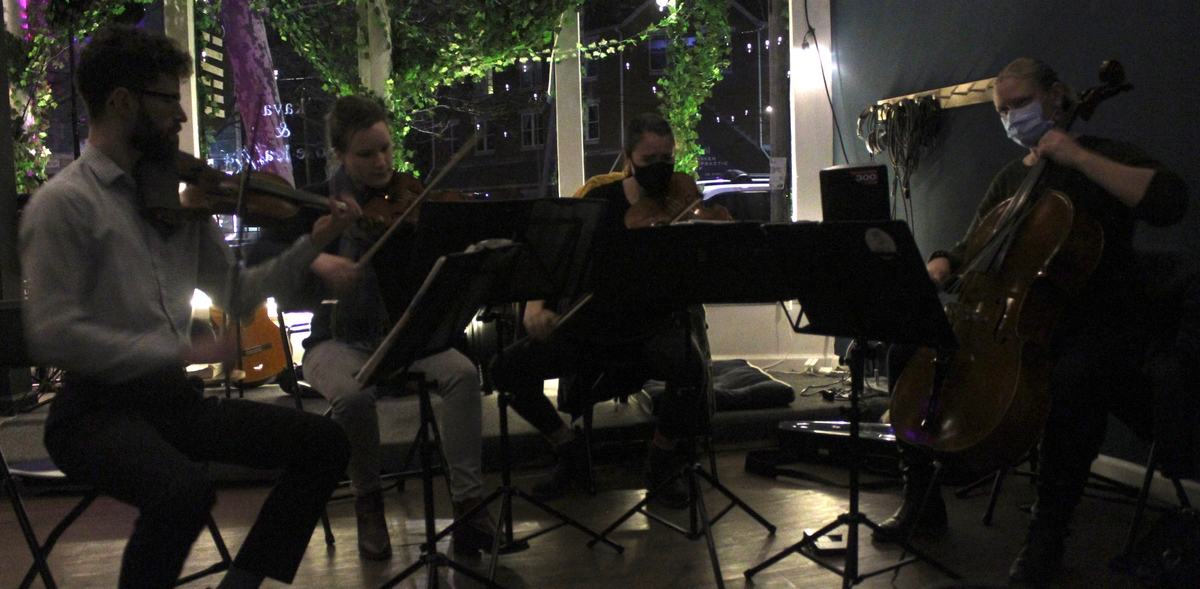
Paul Aguilar of the Callisto Quartet looked over the growing audience assembled at Gather on Upper State Street Thursday night. “Cool thing,” he said. “Literally today is Mozart’s birthday” — his 265th. In honor of that, the quartet was going to perform his famous “Hunt” quartet, “one of the most well-loved pieces” in Mozart’s oeuvre, along with Brahms’s third string quartet, which could be understood as an homage to the Mozart piece.
What followed was a world-class performance, delivered for free to what became a full house at the new coffee shop and community space on Upper State Street.
The Callisto Quartet — Paul Aguilar and Rachel Aguilar on violins, Eva Kennedy on viola, and Hannah Moses on cello — formed in 2016 at the Cleveland School of Music, and since then have performed across the country and the world, picking up numerous accolades along the way. They’re in New Haven as the current fellowship quartet in residence at Yale’s School of Music, a post they assumed in fall 2021 and will hold for two years. They’ll be performing around the country again in the spring. But meanwhile, they were performing in Gather’s intimate setting, for a rapt audience clearly delighted to see them.
And for good reason. The quartet dug into the first movement of “Hunt” with bright tone, sharp phrasing, and exquisite dynamics, setting up both what was to come in the Mozart and Brahms on the page and what the musicians could do with it. A few people walked in during the movement and waited in the doorway.
“You guys can come in,” Kennedy said, waving them into the space, garnering a small ripple of laughter from the audience. “This is casual. For those of us just joining us, this is Mozart’s ‘Hunt’ string quartet, the second movement.”
That movement started off more lyrical, then broke into a trot, the first violin skipping over the top. More people kept coming into the space. Passersby on the street looked in, saw what was happened, slowed their walk, and smiled. The third movement featured a yearning melody passing from instrument to instrument, which the quartet handled with delicacy and reverence while keeping it conversational, only to widen and deepen their sound during the movement’s more choral passages. The fourth movement then took off like a shot, the musicians fluent and fleet-footed, using dynamics to make certain passages shimmer. The Callisto Quartet brought out how much life there is in Mozart’s music still: the jokes, the passions, the moments of wistfulness and sorrow, the knowing asides. The audience, now mostly filling the space, had already dispensed with the convention of withholding applause in between movements, but let it out most heartily at the end.
“It’s really clear to hear the inspiration Brahms took from Mozart,” Kennedy said to introduce the composer’s third string quartet. They were written in the same key, and Brahms included some of the same kinds of musical ideas, the calls of hunting horns, a certain drive in the rhythm. “But Brahms makes it his own,” Kennedy added, introducing rhythmic and melodic complexities of a kind that Mozart would not have written. “We think this is one of the most underrated gems in the repertoire,” she said. It was also one of the first pieces Callisto learned as a quartet, “before we knew what we were getting ourselves into,” Kennedy said, to laughter.
Brahms’s third string quartet is, in a word, difficult. But although “there’s not a cello part in this piece,” as Kennedy related that Brahms told a friend, “there’s a viola part so nice it’ll make you want to switch instruments.” She paused. “That’s another reason I like it,” she said.
Brahms is a composer that people — including other composers — sometimes love to hate (Tchaikovsky is said to called him both “a giftless bastard” and a “conceited mediocrity”). The Callisto Quartet’s performance was a reminder of why his music remains a staple of the performed repertoire. In the first movement, the musicians played its busier passages — its sharp turns of phrase, its jumps in range, its changes in texture — with a commanding voice. The most strident passages were played with the greatest strength, and pauses held to great dramatic effect. It was impossible for the audience not to break into applause after it, and more people kept coming in.
The quartet then gave weight to the darker, richer second movement, playing its sparser passages with a piercing austerity, creating a few moments of real heartache. In the third movement, the viola — the only unmuted instrument in the quartet — rode the ululations of the other parts with phrases that sent Kennedy up and down the tonal range of her instrument. Passersby now stopped in the window, one man pressing his ear to the glass to hear.
In the fourth movement Brahms gave the violins long, winding passages to navigate, which the Aguilars did with ease and aplomb. The middle featured an almost pastoral hymn before breaking into an insistent rhythm that was on the hunt again. Then the two moods merged, and the quartet came to a rousing close. The audience, now full, burst into cheers.
“Come up and say hi,” Kennedy said, beaming. “Thank you so much for being here.”